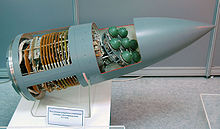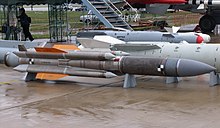Ch-31
| Ch-31 | |
|---|---|
| General Information | |
| Type | Air-to-surface missile |
| Local name | Ch-31 |
| NATO designation | AS-17 krypton |
| Country of origin |
|
| Manufacturer | Zvezda design office |
| development | 1977 |
| Commissioning | 1988 |
| Working time | in service |
| Technical specifications | |
| length |
Ch-31P : 4.74 m. Ch-31PD : 5.34 m |
| diameter | 360 mm |
| Combat weight |
Ch-31P : 610 kg. Ch-31PD : 715 kg |
| span |
Ch-31P : 915 mm Ch-31PD : 1.15 m |
| Drive First stage Second stage |
Ramjet solid fuel booster |
| speed |
Ch-31P : Mach 3.0 Ch-31PD : 2.7-4.5 |
| Range |
Ch-31P : 70 km Ch-31PD : 160 km |
| Furnishing | |
| steering | INS |
| Target location | Radar seeker |
| Warhead |
Ch-31P : 91 kg fragmentation warhead. Ch-31PD : 110 kg fragmentation warhead |
| Detonator | Proximity and impact fuses |
| Weapon platforms | Planes |
| Lists on the subject | |
The Ch-31 ( Russian Х-31 , NATO code name AS-17 Krypton ) is an air-to-surface missile from Soviet production. It is used to combat ground-based radar systems and ships.
development
The Ch-31 was developed as a successor to the Ch-25P . Compared to the previous model, the new guided missile should have a higher cruising speed and a greater range. The new guided missile should be able to combat ground-based and ship-based radar systems. Development began in 1977 in the Zvezda design office . The first flight attempts were made in 1982. In parallel to the anti-radar missile Ch-31P, the anti-ship missile Ch-31A was also developed. The Ch-31P was introduced in small series in the Soviet Air Force in 1988 . The Ch-31 was presented to the public for the first time in 1991. After that it was primarily produced for export.
technology
After the targets have been identified by the aircraft, the guided missiles find their targets by themselves after being dropped ( fire-and-forget ). After the drop, there was a short period of non-propulsion, then the rocket engine ignites at a safe distance. First, the missile is accelerated to Mach 1.8 by the solid fuel booster. If the booster burned out, the covers of the four air intakes are blasted and the Turajew - Ramjet -Marschtriebwerk starts. The Ch-31 can be started at altitudes from 100 to 15,000 m and at speeds from 600 to 1,500 km / h.
The Ch-31P version is used to hold down the enemy air defense ( SEAD ). Your passive radar seeker switches to the frequency of the enemy radar and uses this to hit the radar position. The seeker head can be equipped with interchangeable modules, which u. a. are tuned to the frequency bands of the Hawk and Patriot radars . The seeker head has a gimbal- mounted plate on which seven conical interferometers are attached. The interchangeable search heads L-111 (PRGS-4WP), L-112 (PRGS-5WP), L-113 (PRGS-6WP) and L-122 are available, with newer models the broadband search head L-130 is used, the covers the frequency spectrum from 1–11 GHz . The Ch-31P flies towards the radar system with the help of the seeker head and the autopilot. If the radar system stops transmitting during this time, the Ch-31P maintains the course it has taken and flies to the target with the help of the inertial navigation platform. If the radar system resumes transmission, the passive radar search head switches on again immediately. In addition, target assignment can be carried out after the missile has been launched ( lock-on after launch ). In this case, the Ch-31P is launched into an area with no target position known. Once in the target area, the guided missile searches for targets with the passive seeker head. If the radar radiation from a radar device is detected, this system is attacked. The warhead is detonated by a proximity fuse , ideally around 5 m above the radar system. According to the manufacturer, the expected hit is around 80% and the scattering circle radius ( CEP ) is 5–20 m.
The Ch-31A version is used to combat sea targets and has an active RGS-31 radar seeker . The cruise flight takes place autonomously with the help of the inertial navigation platform, the target approach with active radar control. There are two preprogrammed flight profiles: With the standard flight profile, the cruise flight takes place at an altitude of 15 km at a speed of Mach 3.5. The Mach 3.5 speed is limited by a Mach number detector to limit air friction heating; In the case of the more heat-resistant modification Ch-31PD (as well as the MA-31), the permissible airspeed was increased to Mach 4.5, which also increased the range. The target approach takes place in a 60 ° dive. In the low-altitude profile, the missile flies to the target area at Mach 2.5 at a height of 20–30 m. The target approach then takes place at a height of around 7 m and the impact at the target takes place at wave height in the ship's hull. The penetration warhead ignites with a time delay so that it explodes inside the ship. Due to the high speed, the Ch-31A has a high kinetic energy, which has a great potential for damage.
variants
Soviet Union / Russia
- Ch-31A: Initial version for ship combat with active radar target search. Range 50 km.
- Ch-31P: Initial version for combating radar systems with passive radar target search. Range 70 km.
- Ch-31U: Modified Ch-31P with improved electronics.
- Ch-31PK: Improved Ch-31P. Range 110 km.
- Ch-31AM: Modernized version of the Ch-31A with a longer fuselage and new electronics. Range 150 km.
- Ch-31PM: Modernized version of the Ch-31P with a longer fuselage and new electronics. Range 160 km.
- Ch-31AD: Export version of the Ch-31AM.
- Ch-31PD: Export version of the Ch-31PM.
China
- KR-1: Modified version of the Ch-31P for China .
- YJ-91: Name for the Ch-31PD produced in China.
- YJ-93: Name for the Ch-31AD made in China.
- YJ-12: Further development of the KR-1.
United States

- MA-31: US target display drone for testing air defense systems, (13 pieces).
After an attempt by the USA to develop a targeting missile AQM-127 SLAT based on the ASALM to simulate low-flying supersonic Soviet anti -ship missiles failed, a small (at least 13) number of Ch-31s was purchased from Zvezda in 1995 (cells with engine, without Electronics and warhead) and converted by Boeing to the MA-31. After successful tests, a further 34 pieces were ordered in 1999. At that time there was already considerable political opposition to the project from both Russian and American sides and the sale did not materialize. The missiles already acquired were used as intended; in 2007 the last target drone was used up.
Carrier aircraft
- Mikoyan-Gurevich MiG-27 K
- Mikoyan-Gurevich MiG-29 M / M2 / SMT
- Mikoyan-Gurevich MiG-31 BM
- Sukhoi Su-24M / M2
- Sukhoi Su-30 MK / MKK / MKI
- Sukhoi Su-34
- Sukhoi Su-35
- Sukhoi Su-57
- Xian JH-7
Individual evidence
- ^ Horizon House, Journal of Electronic Defense Staff: International Electronic Countermeasures Handbook, 2004 Edition, p. 150
- ^ Defense Threat Information Group (DTIG): The air-to-ground guided missile system AS-17 Krypton. February 2000
- ↑ Michal Fiszer: Crimson SEAD. in: Journal of Electronic Defense (JED), January 2003.
- ↑ ausairpower.net , accessed on May 16, 2014
- ↑ rbase.new-factoria.ru , accessed on May 16, 2014
- ↑ АО «Корпорация Тактическое ракетное вооружение. Ракета Х-31А. » (Russian)
- ↑ airwar.ru , accessed on May 16, 2014
- ↑ a b c d Piotr Butowski: Russia is preparing a precision guidance revolution for its fast jet, strike, and bomber forces . Jane's International Defense Review, August 2014, United Kingdom, 2014.
- ^ A b Phillip E. Pace: Detecting and Classifying Low Probability of Intercept Radar. Artech House Publishers, 2003. p. 589.
- ↑ AQM-127 SLAT
- ↑ Contracts for Thursday, December 16, 1999. US Department of Defense, December 16, 1999, accessed August 28, 2018 .
- ↑ Boeing / Zvezda-Strela MA-31. www.designation-systems.net, accessed on August 27, 2018 (English).


